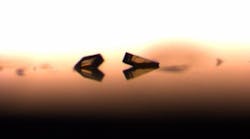Many solids exhibit polymorphism but often just one crystal structure provides the properties that pharmaceutical and specialty chemical makers desire. Unfortunately, preventing production of other polymorphs during batch crystallization generally is tough if not impossible. Now, engineers at the University of Leeds, Leeds, U.K., have developed a method that gives crystals of the desired shape and structure without the usual problems of polymorphism — and that can work in existing equipment. The technique involves placing a self-assembled monolayer (SAM) of molecules on a substrate to act as a nucleation catalyst for a specific polymorph. The Leeds team, working with Ana Kwokal of pharmaceuticals maker PLIVA, Zagreb, Croatia, has produced via batch crystallization the desired form of an active pharmaceutical ingredient called Entacapone, which has six polymorphs. A self-adsorbed layer of Entacapone on a gold substrate promoted the crystallization and controlled the form produced (Figure 1). More details appear in Crystal Growth & Design.“If you imagine the way that oil sits on top of water, that’s similar to how the monolayer works, says Kevin Roberts, a professor in the Faculty of Engineering. “We’ve shown that we can produce a well-defined crystal structure using a self-assembled monolayer bound onto a metal substrate within a regular reactor… Because this is a really simple solution to ensuring consistent crystallization, it has huge potential commercially. Our next steps are to make sure it’s just as efficient on an industrial scale,” he adds.
Desired Crystal
Figure 1. A single form of Entacapone is crystallized on a gold substrate from acetone/water solution.
Source: University of Leeds.
